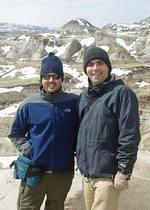Global effort to extract more oil and gas
A University of Adelaide petroleum geologist is spearheading an international project to extract more oil and gas from the ground, potentially saving companies billions of dollars. Associate Professor Bruce Ainsworth from the Australian School of Petroleum (ASP) is a principal investigator of the WAVE Consortium, an industry-sponsored global group that hopes to improve the average extraction rate of 60% from oil and gas fields. "Petroleum companies are generally leaving about 40% of the oil behind due to a number of factors," Dr Ainsworth said. "A large proportion of the remaining hydrocarbon reserves are contained in rocks deposited in marginal and shallow marine environments. When they were laid down these deposits were influenced by waves, tides and river currents that together determine the geometries of our shorelines," he said. The consortium's aim is to study these influences in order to better predict the distribution of oil and gas in the earth's subsurface and to more efficiently extract it from hydrocarbon reservoirs. Eight petroleum companies from around the world - in Australia, Austria, Canada, Egypt, New Zealand, Norway, The Netherlands and the United States - have collectively provided $820,000 for the first phase of the project, which involves the study of ancient and modern coastal systems. The University of Adelaide has employed two postdoctoral researchers, Dr Rachel Nanson and Dr Ivar Midtkandal, who together with Dr Ainsworth and Dr Boyan Vakarelov, a lecturer and co-investigator at ASP, will investigate the wave, tidal and fluvial processes that affect the shoreline. Dr Nanson is in the final stages of a study to determine which of the three processes were responsible for generating Australia's present-day coastline, while Dr Midtkandal will be working in western Canada, examining ancient geological systems to help develop models that can be applied to oilfields. Another Canadian-based researcher is studying the traces that animals left in the sediments over millions of years ago. "Animals only live in certain environments so their traces can give us a better idea of where these sediments were actually deposited and what the predominant influences on the coastlines were," Dr Ainsworth said. Dr Ainsworth has 17 years' experience in the field of petroleum geology and worked in The Netherlands, Canada, Thailand, New Zealand and Western Australia before taking up a research and teaching post at the University of Adelaide in 2007. "We hope to attract sufficient funding to take the project to the next level," he said. Story by Candy Gibson
|





